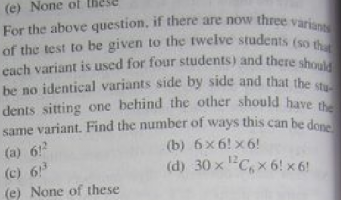Three variants of exam paper are to be given to 12 students. In how many ways can the students be placed in 2 rows of 6 each so that there should be no identical variants side by side and that the students sitting one behind the other should have the same variant. Find the number of ways it can be done

Suppose one row -> __ ___ ___ ____ ___ ___ = first seat has 3 options(VAr 1 ,2 ,3) , second seat has two options (var 1, var 2) assume var 3 has already been placed in first seat , .... 2 options from the second seat to Fifth , last one has one option .
SO expression is (3c1 * 2c1* 2c1 *2c1 * 2c1) = 48
Then 48 * 12 c6 * 6! *6!
WHere am i worng?

Suppose one row -> __ ___ ___ ____ ___ ___ = first seat has 3 options(VAr 1 ,2 ,3) , second seat has two options (var 1, var 2) assume var 3 has already been placed in first seat , .... 2 options from the second seat to Fifth , last one has one option .
SO expression is (3c1 * 2c1* 2c1 *2c1 * 2c1) = 48
Then 48 * 12 c6 * 6! *6!
WHere am i worng?
